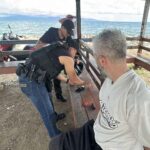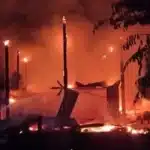SONGKHLA – On Saturday evening, a tragic accident in Chana district, Songkhla, claimed the lives of two teenage girls. Their motorcycle was struck by a train at a level crossing in Tambon Klong Pia, near the Kuan Mit train station.
The victims, Chutimon Chuaipakdee, 14, and Pawinee Nuanthong, 15, were both from Klong Pia. The train driver said he sounded the horn and tried to slow down, but the girls did not react in time.
This loss highlights a serious issue in Thailand: deaths at railway crossings are far too common, adding to the country’s wider struggles with road safety and the risks posed by unprotected crossings.
Train Crossings Are a Common and Deadly Problem
Collisions at level train crossings often make headlines in Thailand. Exact numbers for train-related deaths are hard to pin down, but studies covering 2000 to 2020 report a total of 76 rail accidents and 87 deaths. Some sources say train collisions or incidents are reported almost every week, with phrases like “another train-car collision” popping up regularly in the news.
Several factors contribute to the problem. The rail system uses old equipment, and improvements have not kept up with the need for safety. Funding has focused more on expanding roads than on making rail crossings safer.
Thailand often ranks near the top worldwide for road deaths. World Health Organization data shows the country loses about 50 people per day in road accidents, based on estimates from 2021. Motorcyclists face the greatest risk, making up over 80% of road fatalities. The Songkhla crash, which killed two teens on a motorcycle, fits into this broader pattern.
Why are Thailand’s roads so dangerous? Several reasons stand out:
- Drivers often go well over the speed limit.
- Drunk driving remains a major issue.
- Not everyone wears a helmet, even though it’s required by law.
- Many roads lack proper safety features.
- Fines for breaking the rules are low, and traffic laws aren’t always enforced.
The Dangers of Unprotected Railway Crossings
A big part of the problem is the number of railway crossings without safety barriers. In 2015, of the 2,517 crossings nationwide, 1,933 were legal, but many still had no gates. There are also hundreds of unofficial crossings that locals use as shortcuts, which adds to the danger.
At these unprotected sites, drivers and pedestrians must look out for themselves. Warning signs are often the only alert, and they aren’t always enough. Many crossings lack automatic gates, lights or staff to guide people. Even if trains sound their horns, people can miss the warning, especially if they’re distracted or not familiar with the area. The Songkhla crash was a tragic example: despite the train driver’s warning, the girls didn’t stop in time.
The State Railway of Thailand has warned against building illegal crossings and admits there are risks at intersections without barriers. Still, progress on safety upgrades has been slow, and many communities are left exposed to accidents that could be avoided.
The deaths in Songkhla remind us that more must be done to improve safety. Thailand needs to invest in better protection at railway crossings, step up enforcement of traffic laws and spread awareness about the risks. Better infrastructure and a stronger focus on safe driving can help protect everyone on the roads and tracks. Only with real action can tragedies like this be prevented in the future.















